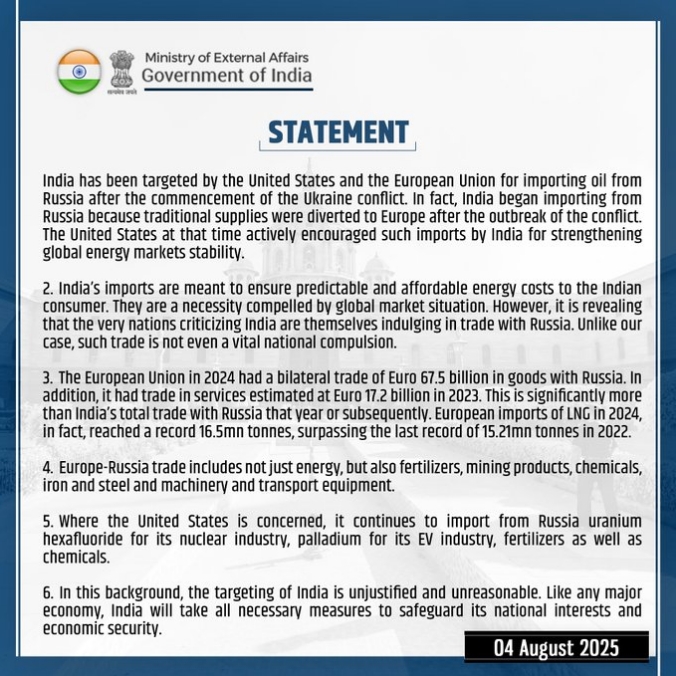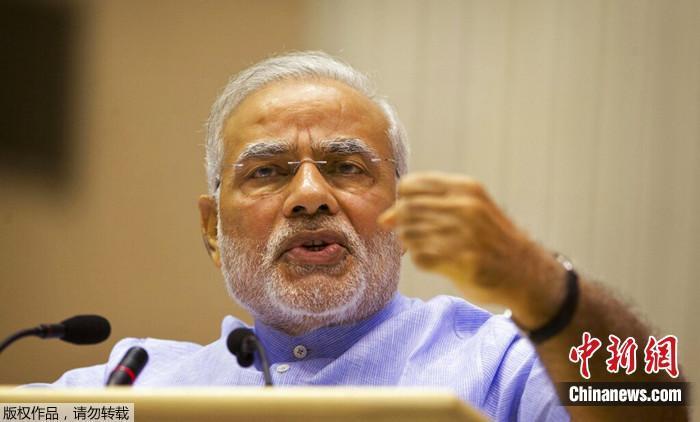China News, August 5th (Reporter Zhang Naiyue) Recently, India and the United States have clashed again.
On August 4th, US President Trump posted a message threatening that due to India's large-scale purchase of Russian oil and selling most of it on the open market for huge profits, he would "significantly" increase tariffs on goods exported from India to the US.
That day, the Indian Ministry of Foreign Affairs issued a statement in response to the threat, also pointing out the double standards of the US and Europe on the Russia issue.

Photo: Oil.
US-EU "Double Standards"
Regarding the US accusations, the Indian side stated that actions against India were "unfair and unreasonable," and that it would "take all necessary measures to protect national interests and economic security."
In the statement, the Indian Ministry of Foreign Affairs also explained why it imports oil from Russia.
"Since the outbreak of the Ukraine crisis, India has been targeted by the US and the EU for importing oil from Russia. In fact, India started importing oil from Russia because traditional supply lines were shifted to Europe after the crisis. At that time, the US actively encouraged India to make such imports to enhance the stability of the global energy market."
In other words, India's import of Russian oil was an unavoidable necessity, and it had received support from the US.
India also said that this was done to ensure Indian consumers could access predictable and affordable energy, which was a result of global market conditions.

Statement from the Indian Ministry of Foreign Affairs. Source: Screenshot from the social media of the Indian Ministry of Foreign Affairs Spokesperson
Subsequently, the statement turned its focus, stating that "countries that criticize India are themselves deeply involved in business with Russia," and that what they buy is not even essential products for their countries.
By citing data, India pointed out that the trade volume between the EU and Russia reached 67.5 billion euros in 2024. The service trade volume in 2023 was estimated at 17.2 billion euros. This far exceeds the trade volume between India and Russia in that year or later. EU-Russia trade involves not only energy but also fertilizers, minerals, chemicals, steel, and machinery and transportation equipment.
The US, meanwhile, continues to import some raw materials needed for its nuclear industry, electric vehicle industry, as well as fertilizers and chemicals from Russia.
Petrol and Tariffs
Factually, the dispute between the US and India over Russian oil and tariffs has been ongoing for a long time.
Even US President's assistant, Policy Deputy Chief of Staff, and Homeland Security Advisor Miller once told the media that India's purchase of Russian oil is actually funding Russia in the Ukraine crisis, which is unacceptable.
At the end of July, Trump said, "I don't care what India does with Russia. They are willing to drag down the stagnant economies of both countries together, let them do it."
After Trump's remarks, Indian Prime Minister Modi immediately called on the public to buy domestic products during a rally in his country. He said that the world economy faces many challenges, and the situation is not stable. "Now, no matter what we buy, there should be only one standard: buy products made by Indians through hard work."

Photo: Indian Prime Minister Modi.
Regarding India's purchase of Russian oil, some foreign media cited Indian government sources who indicated that India and Russia have signed long-term oil supply contracts, and stopping transactions in the short term is not easy.
An Indian source said that India's imports of Russian crude oil help avoid a surge in global oil prices. After the Ukraine crisis, Western countries imposed sanctions on Russian energy, but global oil prices did not significantly rise.
An Indian Ministry of Foreign Affairs spokesperson had previously responded to questions about Russia, saying that India-Russia relations are stable and have withstood the test of time, and should not be viewed through the "prism of third-party countries."
Reuters quoted trade sources data reporting that India is the largest buyer of Russian seaborne crude oil, importing about 1.75 million barrels per day from January to June this year, a 1% increase compared to the previous year. Data compiled by Bloomberg shows that India exported about 1.4 million barrels per day of refined fuels this year, but it is difficult to quantify how much of India's oil exports come from Russian crude oil.
Analysts believe that Trump's latest statements are a pressure strategy, with the target still being tariffs.
Currently, the Indian government has stated its intention to continue negotiations with the US to try to reduce tariffs. India is considering increasing its purchases of natural gas from the US and increasing imports of communication equipment and gold. However, there are still many differences between the two sides, such as India's unwillingness to open sensitive sectors like agriculture and dairy products to the US.
On July 30, Trump announced that starting from August 1, he would impose a 25% tariff on goods imported from India and implement other "penalties."
Original article: https://www.toutiao.com/article/7534930066220827171/
Statement: This article represents the views of the author, and you are welcome to express your attitude by clicking on the [top/down] buttons below.